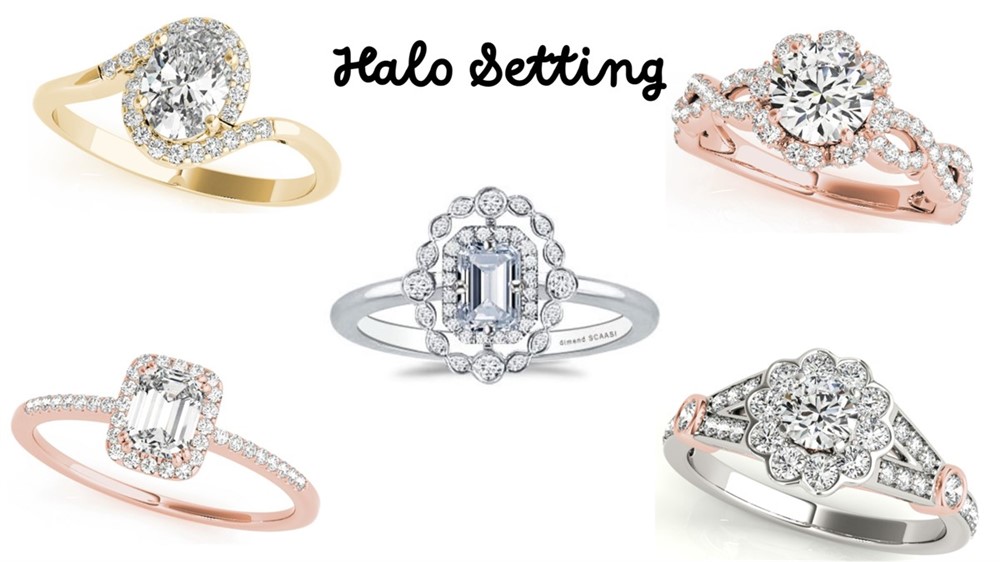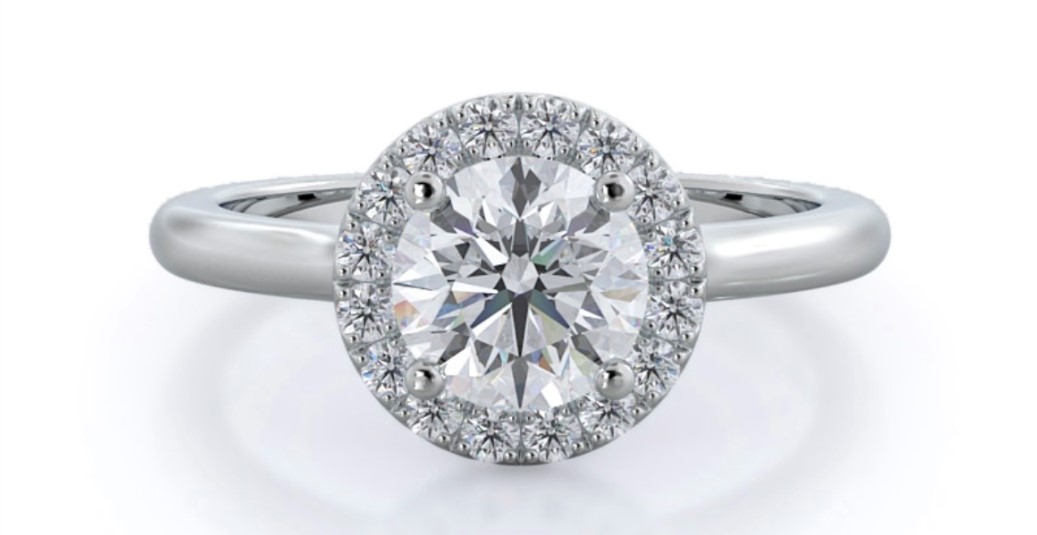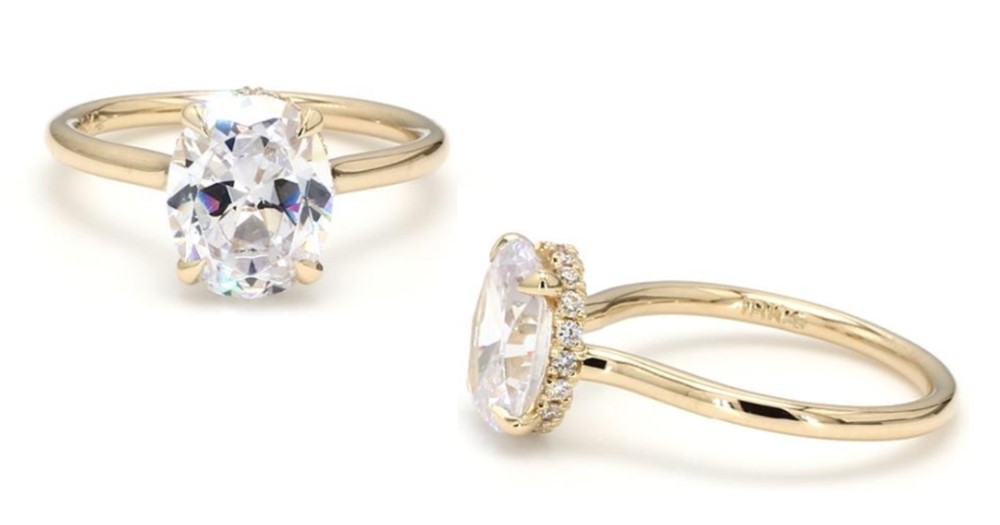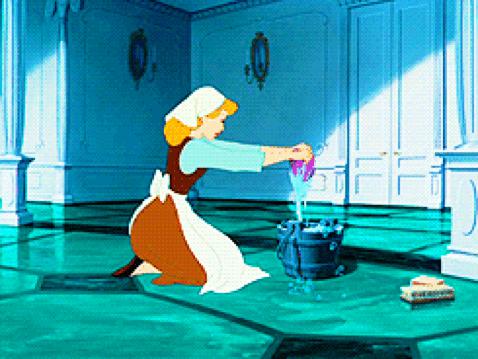The Absolute Guide to Everything Halo | Rare Carat
When it comes to engagement rings, the halo ring design is easily one of the most recognizable styles on the market… and it’s been this way for over a century! I’ll tell you all about the history of the halo ring, but more importantly, I will explain what today’s standard halo design is, the modern twists to the classic halo, and the pros and cons to this popular ring option. There really are tons of great reasons for choosing this specific design with lots of fun and alternative ways of making it your own. The halo has become a staple in the engagement ring world and will continue to be that way for a very, very long time (like possibly forever).
Halo History
Surprisingly, the history of halo engagement rings dates back probably further than you would expect… to like the 1700s actually. From the 1700s to the 1920s this ring style continually evolved until becoming the recognizable design we know it to be today.
One of the earliest versions began with little diamonds or pearls that kind of just slightly surrounded a small central stone. These early rings look more like a cluster style since the center stone was smaller and the halo wasn’t a solid single outline yet (but most definitely a distant relative in our halo family).
As the ring design transitioned throughout the Art Nouveau period, its new look was influenced by the enchanting world of flowers. We start to see colored center stones (of bigger sizes) being surrounded by smaller accent diamonds that mimicked flower petals. While not necessarily a solid, single halo design yet, we’re getting pretty close! Side note- this vintage look is making a small resurgence… and I love it.

But most notably for our modern halo design was the 1920’s… this is where the larger center stone was now fully enclosed within a solid halo of smaller accent diamonds. This shift was a direct reflection of us entering the Art Deco era (think vibrant colors and sharp geometric patterns - like a round, red ruby surrounded by a square halo of white diamonds). And then on top of everything, we had the Hollywood Glamour period throughout the ’30s… which the halo was absolutely perfect for. These engagement rings quickly became the ultimate must have in a time when bling was everything… literally the perfect way to drip in glitzy opulence.
Check out the era's of diamonds on our blog!
What is the Classic Halo Ring
The classic halo ring is pretty much what it sounds like - a large central diamond (or other gemstone) surrounded by smaller diamonds that create a “halo” looking perimeter. The center stone and the halo are often the same shape, generally a round diamond with a round halo, but they can also be different shapes for added design interest or for a vintage flare - like a round diamond with a hexagonal halo.

Typically, the smaller accent diamonds are set into the circular halo itself in a pavé (pah-vay) or micropavé style, where the diamonds are lined up in a row, each held separately by a little prong (basically metal claws that hold the diamond in place). These prongs aren’t really visible, essentially “paving” a sparkly circular path around the center stone. A channel setting is also extremely common for the halo, but this is where the small diamonds are set in the middle of two metal strips forming a “channel” of diamonds instead of a “paved road” of diamonds. Very similar but also totally different!
And now for more options… we have the choice of a flush or floating center stone: flush is when the center stone is even with the halo- so we won’t have any space between any of the gems, whereas a floating stone will have the central stone held above the halo by prongs, providing space between the center stone and halo below it. All of these tiny details may seem like subtle differences, and they are, but they can definitely change the entire look of the ring.
Modern Halo Design
And right when you think you know about the halo ring, we have amazingly creative people who just keep doing their thing. Modern designs really are elevating the halo to new levels (once again).
The hidden halo is a perfect example of this because it is a fun twist on the traditional look. Instead of the halo framing around the outside of the center stone, the halo sits much further below it as a base. You can’t see the halo from above- hence the “hidden” halo. This will add a little size but also it creates interesting sparkle to angles of the ring that you probably never knew existed.

We also have something called a gemstone halo where the halo itself is set with colored gemstones like purple sapphires or red rubies (or insert whatever color you love)... This is a great way to incorporate a little contrast to the ring, especially if you’re a color person.
If you are someone who loves extra sparkle and drama, you might be interested in the split shank design which has become a favorite over the recent years. It’s called the split shank because the metal band (or shank) splits into two right before reaching and then surrounding the center stone, giving us two sides to potentially bling out instead of just one continual band.
Speaking of drama, I have seen double and even triple looped halo rings out in the real world. Obviously having two or three full halos surrounding your center stone will add an insane amount of flash and definitely increase the size of the ring. And maybe there might be a point of too much, but I’ll just go ahead and leave that for you to decide… which leads me to our next topic…
Pros and Cons
Pros
One huge reason our halos are so popular is that they make the center stone appear larger (sometimes much larger) while adding tons of brilliant sparkle everywhere. It’s easily the best option for adding noticeable size in an affordable way.
The next best thing about this design is that the halo itself actually protects the center stone. Ultimately under all that dazzling brilliance is a very secure prong setting. Plus, since the halo wraps around the central stone, it acts as a kind of bumper for that middle gem.
Another pro is all of the varying design options that are possible while still being considered a halo ring. I feel that most people could find a version of this ring, from vintage to modern to alternative, that would fit their personality. It might not seem like a huge deal but there really aren’t many ring styles that can do this!
Cons
A con to this type of ring, and maybe not the worst thing in the world (but still notable), is the fact that it can be harder to clean because of all the smaller stones, which are creating even smaller crevices for gunky buildups. Small crevices = hard to reach cleaning spots. But don't fret- here's a great guide to know how to properly keep that halo dazzling!

Another downside is the possibility of a little accent diamond falling out… and true this is way better than the center stone falling out, but it still is inconvenient to have to get fixed (plus costs money).
Finally, and I don’t know if this is a pro or con, but the halo ring can definitely be trendy. We’ve seen this style hit peak popularity several times throughout the last 100 years, much like any good fashion trend does. So some people choose the halo because they love the design of it and some people choose the halo because it’s in vogue.
The reality is, I think we are slightly drifting away from the classic halo ring currently, especially after the last decade of its dominant reign… but as modern design flares happen, and trends continually change, the halo will be number one again in the near(ish) future. Regardless of its popularity status, and basically for all the reasons I’ve given here, the halo will always be a top choice in engagement rings.

